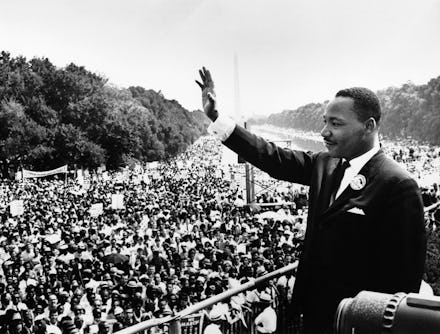The Baltimore Protests Reveal Something Everyone Completely Forgot About the 1960s

As the riots in Baltimore reach violent levels of destruction, people have been quick to draw a stark contrast to the political and social activism that defined the 1960s. Specifically, images like this:
Many people are pointing out how different they are than this:
And this:
Those on the Internet have been vocal in articulating the contrast:
But this logic is deeply flawed. It speaks to the broader narrative of the "peaceful protest" that has infiltrated so much of mainstream knowledge about enacting meaningful societal change. For example: the lunch counter demonstrations. Rosa Parks refusing to give up her seat on the bus. Even one "Bloody Sunday" on the Edmund Pettus Bridge was followed by a peaceful five-day march from Selma, Alabama, to Montgomery. And if you know one thing about Martin Luther King Jr., it's that he was a leader of non-violent protests.
But these events, while monumental, are not the bedrock of the most monumental social movements in American history surrounding racial injustice. King and other leaders within the movement like Bayard Rustin, a Quaker, knew that peace was key to change.
But this narrative also discounts the actions that unfolded in cities like Baltimore, New York, Detroit and Los Angeles during the 1960s that bear striking similarities to the events unfolding in Baltimore this week. These cities burned. People smashed into department stores and stood toe to toe with police. Men, women and children were pelted with rocks, their faces burned with tear gas and their bodies bitten by police dogs.
Images from more violent protests of the 1960s, if they were in full color, could be mistaken for what's happening today.
Philadelphia in 1964
What began as a small incident with police erupted into a five-day riot in a Philadelphia neighborhood known as "the Jungle," a poor area with high rates of unemployment and the worst housing in the city.
Harlem, New York, in 1964
The riots in Harlem were in reaction to the shooting of a 15-year-old boy by a white off-duty police officer. The riot spread to the Bedford-Stuyvesant neighborhood in Brooklyn, and lasted nearly a week.
Rochester, New York, in 1964
The fury from the riots in Harlem also sparked protests upstate, where the National Guard was called in by Gov. Nelson Rockefeller to restore order.
Los Angeles in 1965
The Watts rebellion, as the event is known, was sparked by the arrest of 21-year-old driver Marquette Frye. The struggle lasted six days and resulted in 34 deaths and around 1,000 injuries and 4,000 arrests.
Detroit in 1967
Police raided an unlicensed bar as revelers celebrated two black service members returning home from Vietnam and arrested all 82 people in attendance. Locals retaliated by attacking a police car and shattering a shop window, igniting a five-day riot.
Newark, New Jersey, in 1967
Police arrested a cab driver who drove his car around a police cruiser and double parked. The police report claims the driver was tailgating and driving the wrong way down a one-way street and used offensive language and physical assault. However it seemed that the driver was assaulted by police, spurring people to retaliate.
Washington D.C. in 1968
Young activist Stokely Carmichael marched with a group demanding businesses close in honor of King's assassination in 1968, just as they did to mark the assassination of President John F. Kennedy in 1963. As the crowd grew, so did the anger, and while Carmichael urged others to remain calm, rioters took over the city for several days.
Violence was at the heart of these acts of rebellion because the black citizens in these cities were subjected to rampant police violence, poverty and institutionalized racism that denied them the right to vote, own property and access to fair and equal education. While peaceful demonstrations were important for gaining allies in the fight for racial equality — and are also happening in Baltimore, as Mic's Darnell Moore reported — violent rebellion of the 1960s reflected to America the realities of being a black person at that time.
And it seems history is only repeating itself.
Plenty of people quote King's lessons on nonviolence but forget that in one speech where he says he is committed to "militant, powerful, massive, nonviolence as the most potent weapon," he also acknowledges it would be "morally irresponsible" to condemn riots.
A "riot is the language of the unheard. And what is it America has failed to hear? It has failed to hear that the plight of the negro poor has worsened over the last 12 or 15 years. It has failed to hear that the promises of freedom and justice have not been met. And it has failed to hear that large segments of white society are more concerned about tranquility and the status quo than about justice and humanity."
Three weeks later, King was assassinated. A supreme act of violence.